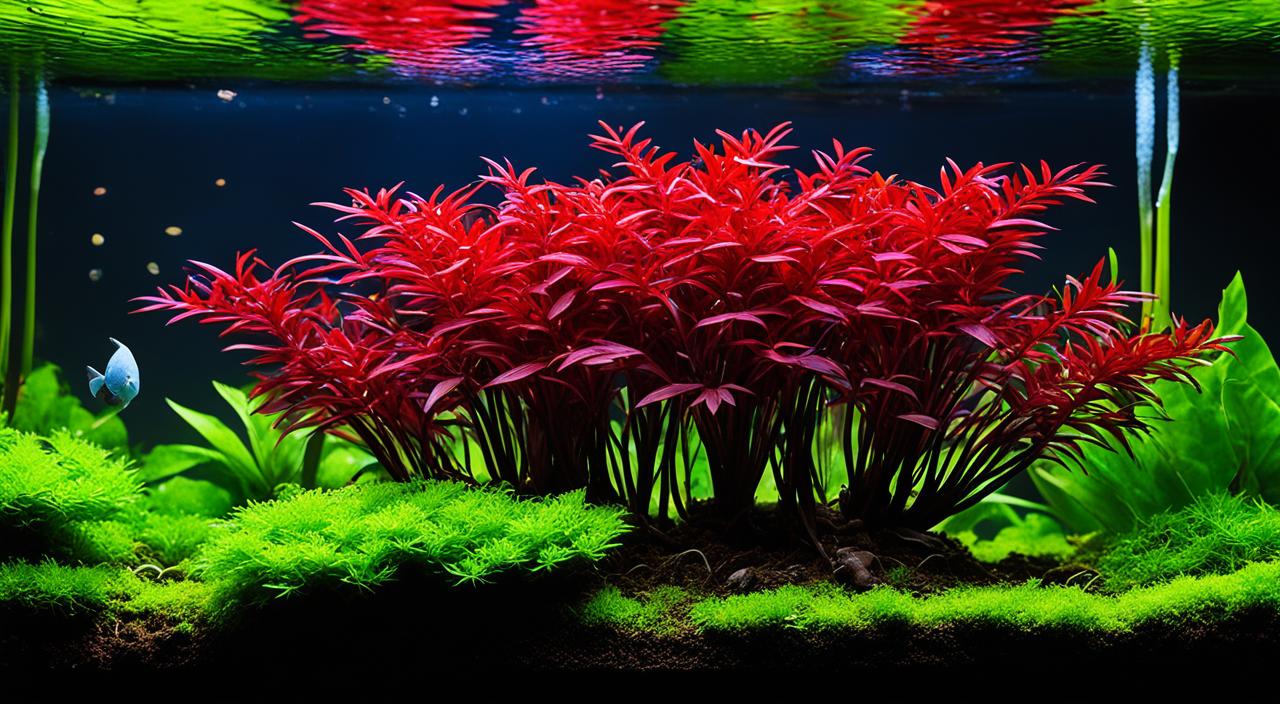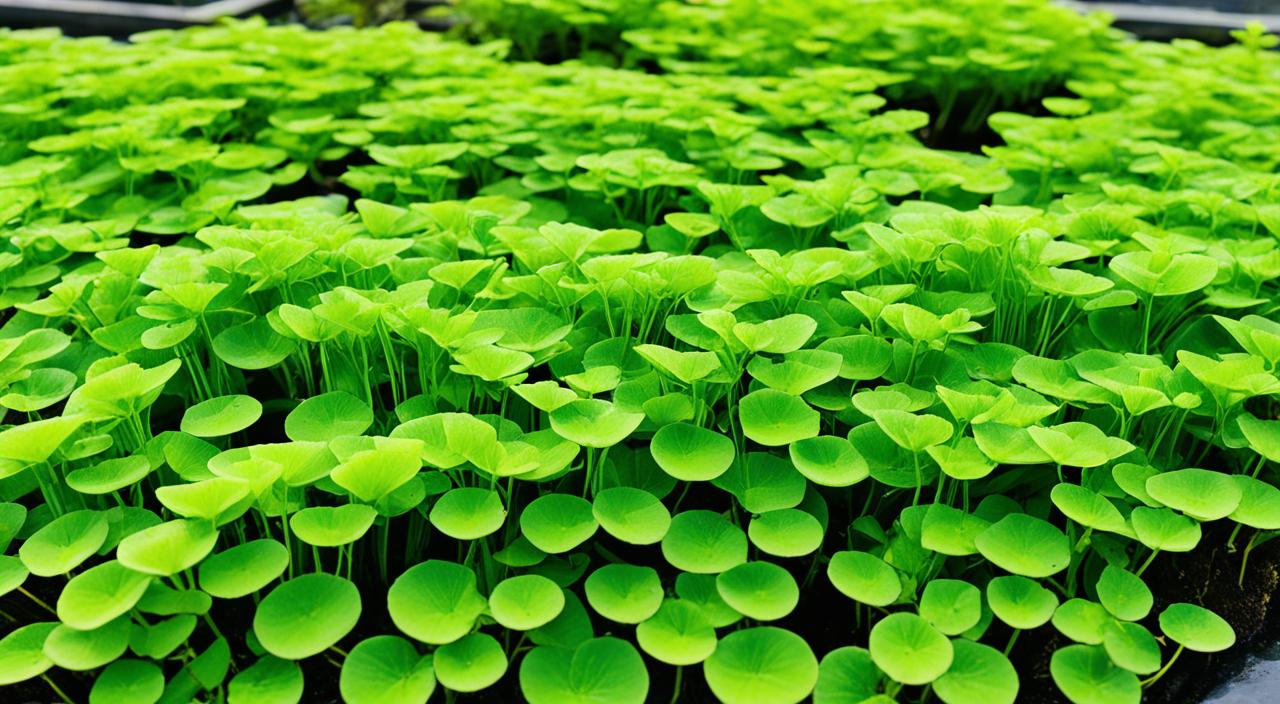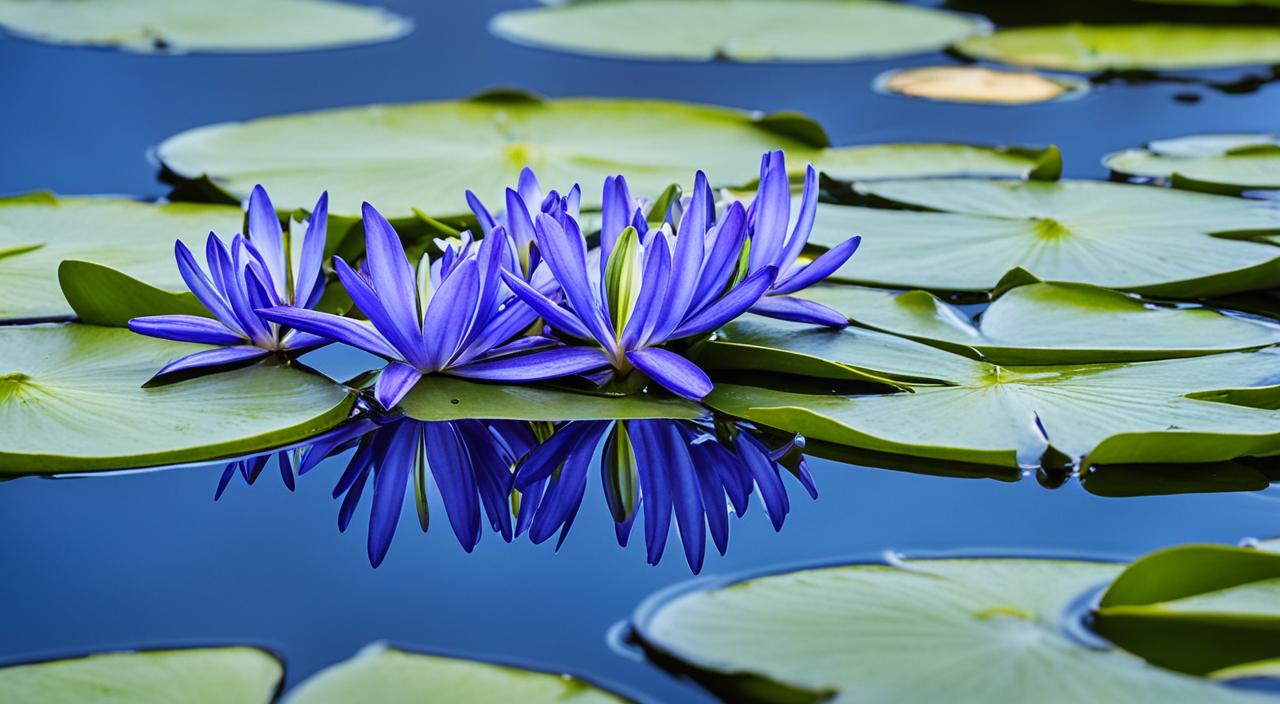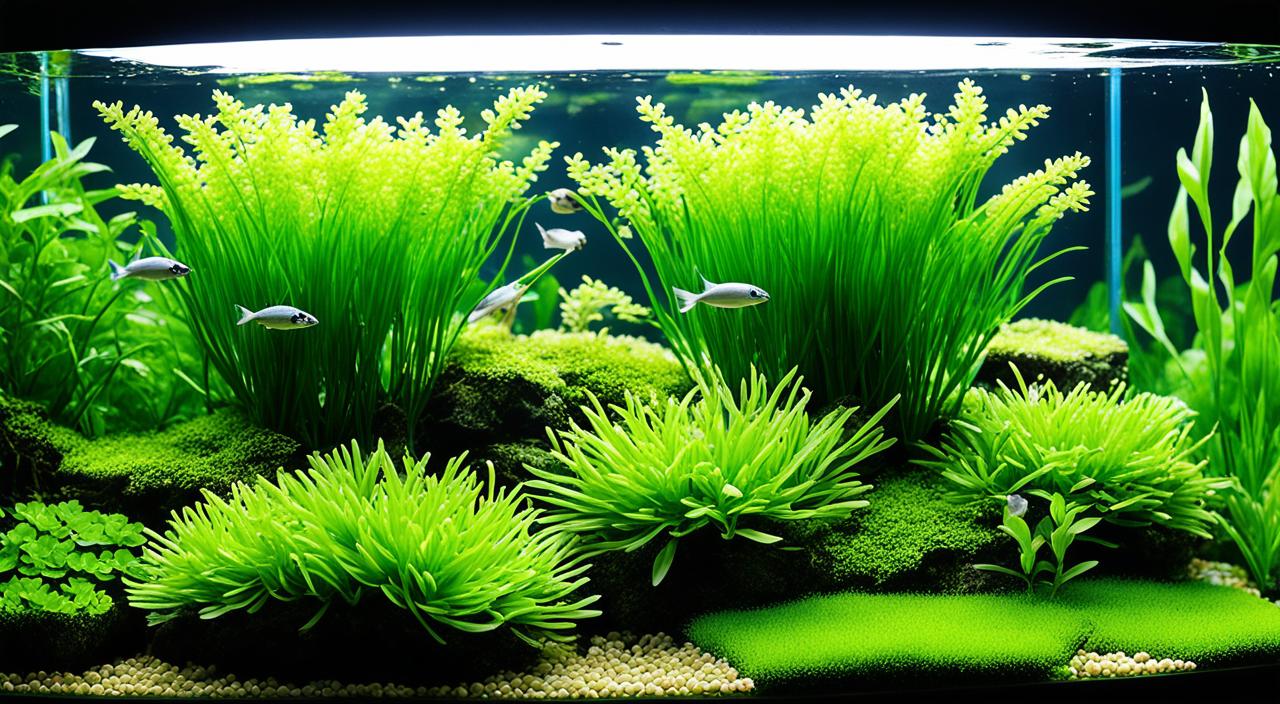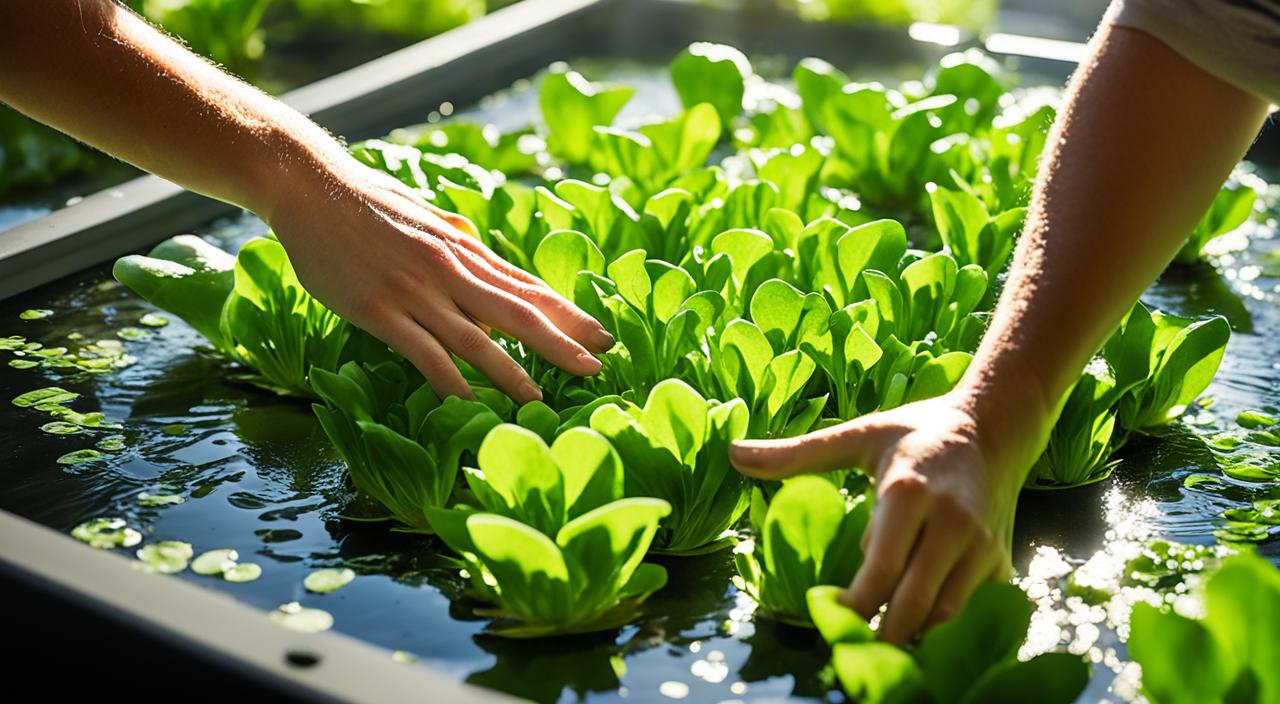Red Root Floater (Phyllanthus fluitans)
The Red Root Floater (Phyllanthus fluitans) is a beautiful floating plant that can add a touch of vibrance to any freshwater aquarium. Not only does it enhance the aesthetic appeal of the tank, but it also provides several benefits to the aquatic ecosystem.
Information Table:
| Floats on the water surface, roots hang downward | Description |
|---|---|
| Scientific Name: | Phyllanthus fluitans |
| Common Names: | Red Root Floater |
| Origin: | South America |
| Height: | It is not necessary, but it can promote better growth |
| Growth Rate: | Fast |
| Colour: | Leaves: Green to reddish, Roots: Bright red |
| Aquarium Placement: | Water surface |
| Water Type: | Freshwater |
| pH: | 6.5 – 7.5 |
| Care Level: | Easy |
| Light Requirements: | Moderate to high, 50-70 PAR, 5000-7000K (full spectrum is ideal), LUX varies depending on tank setup |
| CO2 Requirements: | Not necessary, but it can promote better growth |
| Temperature: | 70°F – 82°F (21°C – 28°C) |
| Flow Rate: | Low to moderate (excessive flow can cause the plant to sink or become damaged) |
| Propagation: | Absorbs nutrients from water; additional fertilization is not typically required, but can benefit from it |
| Feed Type: | Absorbs nutrients from water; additional fertilization is not typically required, but can benefit from it. |
Regarding light requirements, Red Root Floater (Phyllanthus fluitans) thrives under moderate to high lighting conditions. A PAR (Photosynthetically Active Radiation) value of 50-70 is generally sufficient for healthy growth, promoting vibrant leaf colour and root development.
The ideal colour temperature for lighting is between 5000K and 7000K, simulating natural daylight and effectively supporting photosynthesis. While specific LUX values can vary based on the depth and clarity of the tank, providing a full spectrum light source ensures that the plants receive a balanced range of light wavelengths. It’s important to note that while red root floaters can adapt to various lighting conditions, consistently high light levels can enhance the red colouration of the roots and promote denser foliage.
Good Tank Mates
When it comes to choosing tank mates for the Red Root Floater, there are several fish species and aquatic organisms that can coexist peacefully with this plant. Some of the compatible fish species that make suitable companions for Phyllanthus fluitans include:
- Neon Tetras
- Cherry Shrimp
- Dwarf Gouramis
- Otocinclus Catfish
- Corydoras Catfish
These fish species are known to be non-aggressive and have a peaceful temperament, making them ideal companions for the Red Root Floater. They can also tolerate similar water parameters and provide a visually appealing contrast to the floating plant.
Fish Species To Avoid
While many fish species can peacefully coexist with the Red Root Floater, some species are unsuitable tank mates and should be avoided. These fish species may harm or consume the delicate foliage of the plant. It is recommended to avoid the following fish species when keeping the Red Root Floater:
- Goldfish
- Cichlids
- Barbs
- Silver Dollars
These fish species are known to be more aggressive or tend to nip at aquatic plants’ foliage. Their presence in the tank can damage or lose the Red Root Floater.
Choosing compatible fish species as tank mates for the Red Root Floater is crucial to maintaining a harmonious and balanced aquatic ecosystem. Selecting suitable companions can create a visually stunning and thriving environment for the fish and the floating plant.
| Fish Species | Tolerance | Compatibility |
|---|---|---|
| Neon Tetras | High | Compatible |
| Cherry Shrimp | Medium | Compatible |
| Dwarf Gouramis | High | Compatible |
| Otocinclus Catfish | Medium | Compatible |
| Corydoras Catfish | High | Compatible |
Feeding (Fertilization)
While the Red Root Floater mainly derives nutrients from the water, proper feeding and fertilization are essential for its growth and overall health. In this section, we will discuss how much and how often to feed the Red Root Floater and suitable fertilization methods. Providing the necessary nutrients will ensure that the plant thrives and enhances the aquarium’s water quality.
How Much And How Often To Feed
It’s essential to strike the right balance when feeding the Red Root Floater. Overfeeding can lead to excessive nutrient buildup and water pollution while underfeeding can deprive the plant of essential nutrients. Aim to feed the Red Root Floater small amounts of fish food or specially formulated plant fertilizers.
As a general guideline, feeding the Red Root Floater 2-3 times a week is sufficient. Start with a small portion and observe the plant’s response. If the plant appears healthy and continues to grow, you can maintain the same feeding frequency. However, if you notice excessive growth or nutrient deficiencies, you may need to adjust the feeding schedule accordingly.
Suitable Fertilization Methods
In addition to regular feeding, providing appropriate fertilization methods can further support the growth and vitality of the Red Root Floater. The plant requires a balanced supply of essential nutrients, including nitrogen, phosphorus, and potassium.
One common approach is to utilize liquid fertilizers formulated explicitly for aquatic plants. These fertilizers can be added to the water according to the manufacturer’s instructions. Alternatively, you can opt for root tab fertilizers placed directly in the substrate near the plant’s roots to provide targeted nutrient uptake.
Regularly monitoring the nutrient levels in the water and adjusting the fertilization regimen is crucial for maintaining optimal conditions for the Red Root Floater’s growth and nutrient requirements.
CO2 Injection
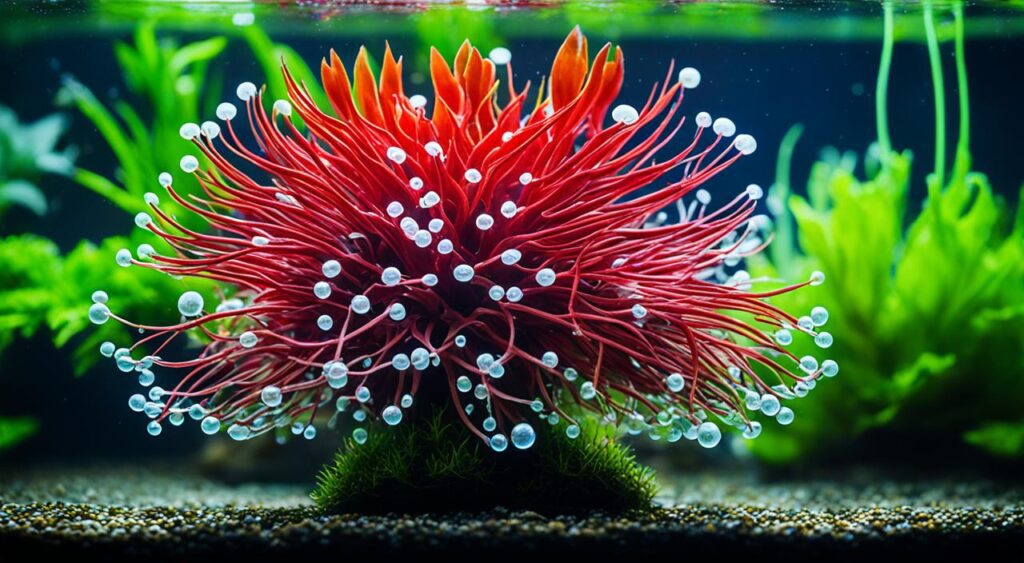
While CO2 injection is unnecessary for the Red Root Floater, some aquarium enthusiasts may supplement it with additional CO2. Understanding the concept of CO2 injection and the different types available can help aquarium keepers decide whether to incorporate it into their Red Root Floater’s care routine.
Types
Different CO2 injection methods can be used in aquariums to provide the Red Root Floater with additional carbon dioxide. These methods include:
- Pressurized CO2 Systems: This method involves a pressurized canister of CO2 gas that is regulated and released into the aquarium. It requires a CO2 regulator, diffuser, and a CO2-proof tubing system.
- DIY CO2 Systems: Some aquarium enthusiasts prefer to create their CO2 injection systems using everyday materials. These systems typically consist of a yeast, sugar, and water mixture that produces CO2 as a byproduct of fermentation.
- Liquid CO2 Supplements: Liquid CO2 supplements, such as glutaraldehyde-based products, can be added directly to the aquarium water to provide a carbon source for the Red Root Floater.
It’s important to note that CO2 injection can significantly affect the pH and carbonate hardness of the aquarium water. Therefore, monitoring these parameters carefully and adjusting as needed to maintain a stable and suitable environment for the Red Root Floater and other aquatic inhabitants is crucial.
Care
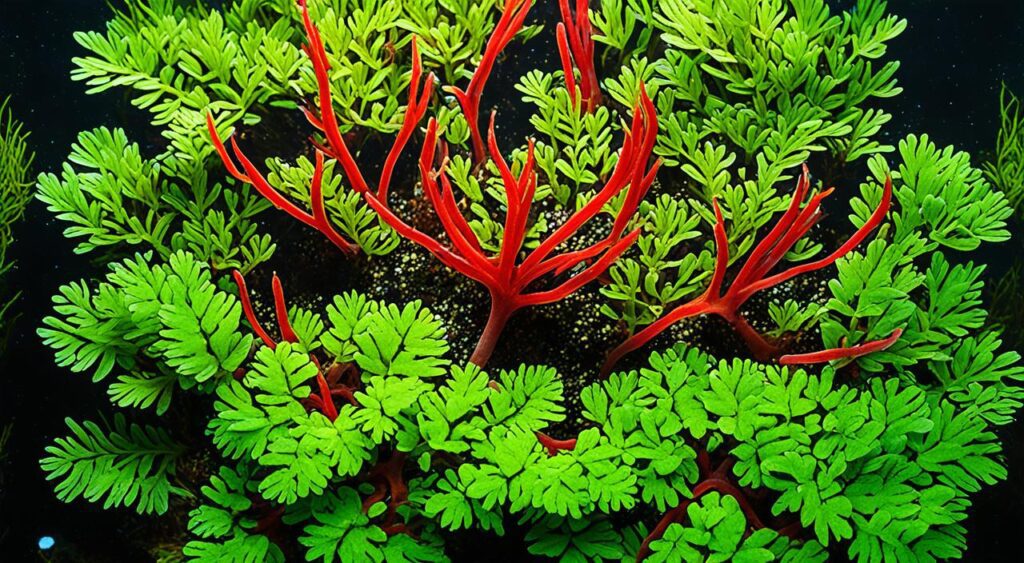
Proper care is essential for the health and well-being of the Red Root Floater. This section will provide comprehensive care instructions, including planted tank parameters, water quality considerations, filtration recommendations, and flow requirements. Implementing these care tips will ensure the Red Root Floater thrives and contributes to a balanced aquatic ecosystem.
Planted Tank Parameters
Creating the right environment is crucial for the growth of Red Root Floaters. Here are some key planted tank parameters to keep in mind:
- Lighting: Provide moderate to high-intensity lighting to support photosynthesis in the plants. Use a timer to ensure consistent light cycles.
- Temperature: Maintain the water temperature between 70-80°F (21-27°C). Avoid extreme fluctuations.
- pH Level: Aim for a slightly acidic to neutral pH range of 6.5-7.5. Regularly test the water to monitor pH levels.
- Substrate: Use a nutrient-rich substrate to provide essential nutrients to the Red Root Floaters.
- CO2 Injection (optional): Supplemental CO2 may enhance growth, but it is not necessary for the health of Red Root Floaters.
Water Quality
Maintaining optimal water quality is crucial for the well-being of Red Root Floaters. Follow these guidelines to ensure good water quality:
- Ammonia and Nitrite levels should always be zero. Regular testing and proper filtration will help achieve this.
- Nitrate levels should be kept below 20 ppm. Perform regular water changes to control nitrate levels.
- Maintain proper oxygen levels in the water through adequate surface agitation and gas exchange.
- Monitor and maintain the hardness of the water within the range suitable for the Red Root Floaters.
Filtration
An efficient filtration system is vital for maintaining the cleanliness and water parameters required by Red Root Floaters. Consider the following:
- Choose a filtration system that provides mechanical, biological, and chemical filtration.
- Regularly clean and maintain the filter media to prevent clogging and ensure optimal performance.
- Be cautious with solid water currents as they may cause damage to the delicate roots of the Red Root Floaters.
Flow
Proper water flow is essential for the overall health of Red Root Floaters. Consider the following flow requirements:
- A gentle to moderate water flow prevents stagnation and promotes nutrient distribution.
- Avoid strong currents that may uproot or damage the delicate Red Root Floater leaves and roots.
- Strategically place your filtration outlets or use a flow controller to adjust the flow according to the needs of the Red Root Floaters.
Aquarium Maintenance
Regular aquarium maintenance is essential for the overall health and longevity of the Red Root Floater. This section will discuss various aspects of aquarium maintenance, including testing water conditions, setting up the aquarium tank, and propagation methods for the Red Root Floater. Following proper maintenance practices will ensure this beautiful floating plant’s continuous growth and propagation.
Testing Water Conditions
Testing water conditions is crucial to maintaining a healthy environment for the Red Root Floater. Regular testing helps ensure that the water parameters are within the optimal range for the plant’s growth. Conducting tests for pH levels, ammonia, nitrite, and nitrate levels will provide valuable insights into the water quality. Based on the test results, appropriate measures can be taken to maintain a stable and suitable aquatic environment.
How To Set Up Your Aquarium Tank
A proper aquarium setup is essential for the well-being of the Red Root Floater. When setting up the tank, consider the specific needs of this floating plant. Provide adequate lighting, as Red Root Floaters thrive in moderate to high light conditions. Additionally, ensure the tank has a suitable substrate or floating mat to anchor the roots and allow the plant to spread. Setting up the aquarium tank correctly creates an optimal environment for the Red Root Floater to grow and flourish.
Propagation Methods
Propagating the Red Root Floater is an exciting part of maintaining this plant in your aquarium. You can use several methods to propagate Red Root Floaters, including division and runners. Division involves separating the plant into smaller portions and replanting them in different tank areas. Conversely, runners are elongated stems that produce new plantlets that can be separated and grown independently. Understanding and implementing these propagation methods will allow you to expand your Red Root Floater population and create a lush aquatic landscape.
| Maintenance Tasks | Recommended Frequency |
|---|---|
| Cleaning debris from the water surface | Weekly |
| Trimming overgrown roots and foliage | As needed |
| Checking and adjusting water parameters | Weekly |
| Pruning and thinning out dense patches | Monthly |
| Removing dead or dying plant matter | Weekly |
Health And Disease
Monitoring the health of the Red Root Floater is crucial for its well-being. In this section, we will discuss the signs of good and poor health to look out for in this plant. We will also explore common health issues the Red Root Floater may face and the appropriate treatment methods. Additionally, we will address common plant pests and how to prevent and deal with them effectively.
Signs Of Good Health
Recognizing the signs of good health in Red Root Floater is essential for ensuring optimal growth and vitality. Here are some indicators of a healthy plant:
- Rich green colouration: A vibrant, lush green colour indicates a healthy Red Root Floater.
- Robust root system: Well-developed and extensive roots suggest a plant obtaining sufficient nutrients from the water.
- Robust growth: Rapid and consistent growth is a positive sign that the Red Root Floater is thriving in its environment.
- Abundant rootlets: Tiny rootlets growing from the primary roots indicate active nutrient uptake and propagation.
Signs Of Poor Health
Identifying the signs of poor health in the Red Root Floater is crucial for timely intervention. Here are some signs that may indicate poor plant condition:
- Yellowing or browning leaves: Discolored leaves can indicate nutrient deficiency, inadequate lighting, or stress.
- Wilting or decay: Drooping or decaying leaves suggest a lack of water circulation, improper nutrient balance, or disease.
- Stunted growth: Slow or limited growth indicates suboptimal growing conditions or nutrient deficiencies.
- Root damage: Damaged or decaying roots can result from poor water quality, overcrowding, or nutrient imbalance.
Common Health Issues And Treatment
The Red Root Floater may encounter various health issues that can impede its growth and overall well-being. Here are some common health issues and their appropriate treatment methods:
| Health Issue | Treatment |
|---|---|
| Nutrient Deficiency | Supplement with appropriate aquatic plant fertilizers to ensure the plant receives essential nutrients. |
| Algae Overgrowth | Control algae growth through proper lighting, nutrient management, and regular maintenance practices such as water changes. |
| Disease or Infection | Isolate affected plants and treat with suitable aquatic plant-safe treatments or consult a professional for advice. |
| Water Quality Issues | Maintain proper water parameters, including temperature, pH, and ammonia and nitrate levels, to ensure a healthy environment for the plant. |
Plant Pests
Like other aquatic plants, the Red Root Floater is susceptible to pests that can hinder its growth and cause damage. Here are some common plant pests to watch out for:
- Snails: Snails can consume Red Root Floater leaves, leading to plant deterioration. Manual removal or introduction of snail-eating fish can help control the population.
- Planaria: These small flatworms can multiply in the aquarium and harm the Red Root Floater. Remove planaria manually or use appropriate treatments to eradicate them.
- Hydra: Hydra are small predatory animals that can harm Red Root Floater. Remove hydra manually or consider using suitable treatments to eliminate them.
- Other Insects: Beetles, flies, or larvae can also damage the Red Root Floater. Monitor the plant and manually remove any visible insects.
By carefully observing the signs of good health, identifying signs of poor health, addressing common health issues, and managing plant pests, you can ensure the well-being and longevity of your Red Root Floater in the aquarium.
Summary
Throughout this article, we have explored the fascinating world of the Red Root Floater (Phyllanthus fluitans) and its suitability as a freshwater aquarium plant. We have covered various aspects of this floating plant’s care, from tank mates to care requirements, to help you create a thriving aquatic ecosystem.
The Red Root Floater can coexist peacefully with compatible fish species and other aquatic organisms, making it a versatile addition to any aquarium. By selecting suitable tank mates, you can promote harmony and balance in your tank while enhancing its visual appeal.
Proper care is critical to ensuring the health and growth of the Red Root Floater. From maintaining optimal planted tank parameters and providing good water quality to implementing the proper filtration and flow, following these care tips will help your Red Root Floater flourish.
In addition to understanding its care requirements, it is essential to monitor the health of the Red Root Floater. By recognizing signs of good health and identifying potential issues promptly, you can ensure the well-being of this plant and take appropriate measures when necessary.
In conclusion, the Red Root Floater is a beautiful and beneficial addition to freshwater aquariums. By carefully considering its care requirements, selecting suitable tank mates, and monitoring its health, you can enjoy the beauty and benefits of this floating plant in your aquarium.
FAQ
What are good tank mates for the Red Root Floater?
The Red Root Floater can coexist peacefully with various fish species and other aquatic organisms. Some good tank mates for the Red Root Floater include guppies, tetras, rasboras, and dwarf shrimp. These species are compatible and can thrive alongside this plant, creating a harmonious and balanced ecosystem in the aquarium.
What fish species should I avoid when keeping the Red Root Floater?
It is important to avoid certain fish species that may harm or consume the Red Root Floater. Fish species such as goldfish, cichlids, and larger aggressive fish should be avoided as they may damage or eat the plant. Choosing suitable tank mates is crucial for the well-being of the Red Root Floater.
How much and how often should I feed the Red Root Floater?
While the Red Root Floater mainly derives nutrients from the water, proper feeding and fertilization are still essential for its growth and overall health. It is recommended to feed the Red Root Floater sparingly, as overfeeding can lead to excess nutrients in the water. A small pinch of fish flakes or pellets once or twice a week is sufficient for the plant’s nutritional needs.
Do I need to supplement the Red Root Floater with CO2 injection?
CO2 injection is not necessary for the Red Root Floater, as it can obtain carbon dioxide from the surrounding air. However, some aquarium enthusiasts may choose to supplement CO2 to enhance growth and promote lush foliage. If you decide to incorporate CO2 injection, there are different types of CO2 injection systems available, including CO2 diffusers and CO2 injectors.
How do I care for the Red Root Floater in my aquarium?
Proper care is essential for the health and well-being of the Red Root Floater. It is important to maintain the appropriate planted tank parameters, such as temperature, pH, and lighting. Ensuring good water quality through regular water changes and adequate filtration is also crucial. Additionally, providing the right amount of flow in the aquarium helps to distribute nutrients and maintain healthy growth of the plant.
How do I maintain my aquarium with the Red Root Floater?
Regular aquarium maintenance is important for the overall health of the Red Root Floater. This includes testing water conditions regularly to ensure proper pH, ammonia, and nitrate levels. Setting up the aquarium tank correctly, including substrate and lighting, is also crucial for the plant’s growth. Propagation methods such as dividing and replanting the Red Root Floater can help it spread and create a more lush appearance in the tank.
What are the signs of good health and poor health in the Red Root Floater?
Signs of good health in the Red Root Floater include vibrant green leaves, root development, and active growth. On the other hand, signs of poor health include yellowing or browning leaves, wilting, and stunted growth. It is important to monitor the plant closely and address any issues promptly to ensure its well-being.
What are common health issues that the Red Root Floater may face?
The Red Root Floater may encounter common health issues such as nutrient deficiencies, algae growth, and damage from fish or pests. Nutrient deficiencies can be addressed through proper fertilization, while algae growth can be controlled through balanced lighting and nutrient levels. Damage from fish or pests can be prevented by choosing suitable tank mates and implementing preventive measures such as quarantine and pest control.

